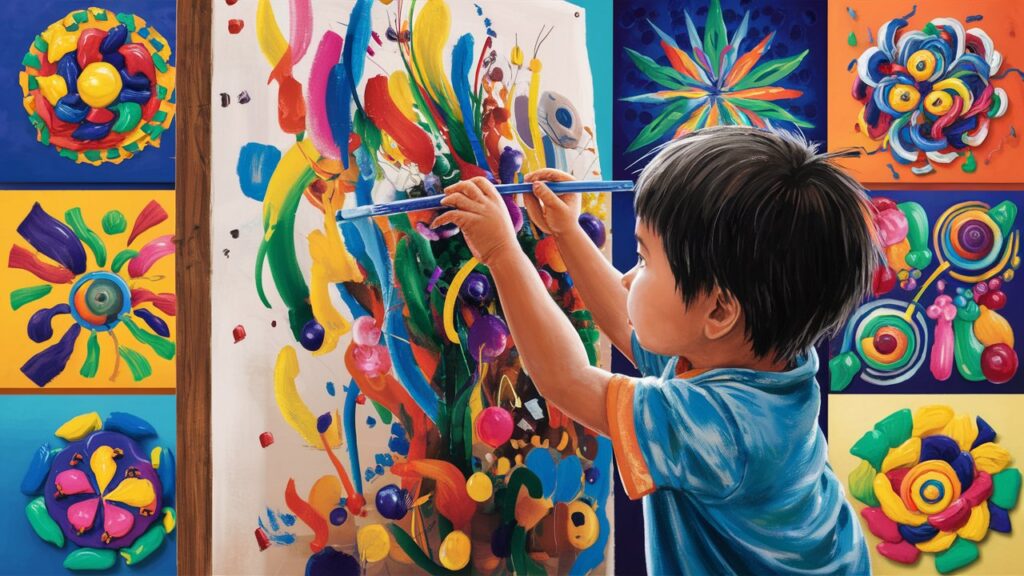Introduction
In today’s visually driven world, fostering creativity in children requires innovative tools that spark imagination. Abstract backgrounds, with their vibrant colors, dynamic shapes, and limitless interpretations, offer a unique canvas for young minds to explore. KidsTurnCentral, a hub for child-centered creative resources, provides a treasure trove of abstract designs that educators, parents, and caregivers can harness to inspire artistic expression, learning, and play. This article delves into the power of abstract backgrounds, how to integrate them into activities, and practical tips for maximizing their potential. From art projects to educational tools, discover how these versatile visuals can transform the way children engage with the world around them.
The Role of Abstract Backgrounds in Child Development
Abstract backgrounds are more than just eye-catching patterns—they serve as a gateway to cognitive and emotional growth. Unlike literal imagery, abstract designs encourage children to interpret shapes, colors, and compositions without predefined boundaries. This freedom stimulates critical thinking, as kids learn to associate emotions with color palettes or invent stories inspired by swirling lines and geometric forms. For instance, a jagged red-and-black pattern might evoke excitement or tension, while soft pastel gradients could inspire calmness. By engaging with abstract visuals, children develop observational skills, emotional intelligence, and the confidence to express their unique perspectives.
KidsTurnCentral’s collection of abstract backgrounds is curated to align with developmental milestones. Their designs range from simple high-contrast patterns for toddlers to intricate mosaics for older children, ensuring age-appropriate engagement. Integrating these backgrounds into daily activities—whether through coloring sheets, digital art apps, or classroom displays—provides a foundation for creative exploration that adapts to a child’s evolving abilities.
How to Harness Abstract Backgrounds for Creative Projects
Harnessing abstract backgrounds effectively requires intentionality. Start by selecting designs that resonate with a child’s interests or a project’s theme. For example, a space-themed activity could use KidsTurnCentral’s starry nebulae patterns, while a lesson on emotions might incorporate abstract faces with exaggerated expressions. Print these backgrounds as coloring pages, layer them under collages, or project them onto walls for immersive storytelling sessions.
Digital tools expand the possibilities further. Use KidsTurnCentral’s downloadable backgrounds as tablet wallpaper for drawing apps, allowing children to trace, annotate, or animate their creations. Pair abstract visuals with mixed-media projects: glue textured materials like fabric or sand onto printed designs to explore tactile and visual contrasts. Educators can also incorporate these backgrounds into slideshows or worksheets to make lessons visually dynamic, helping students retain information through engaging formats.
Integrating Abstract Backgrounds into Learning Activities
Abstract backgrounds are powerful tools for interdisciplinary learning. In math, geometric patterns from KidsTurnCentral can illustrate symmetry, fractions, or tessellation concepts. Encourage children to identify shapes, count repetitions, or even create their own patterns based on mathematical principles. For language arts, use abstract scenes as writing prompts—ask students to describe the “world” they see in a chaotic splash of colors or invent characters that inhabit a minimalist design.
Science lessons can leverage abstract backgrounds to explain natural phenomena. A watercolor-like gradient might represent the layers of the ocean, while fractured lines could symbolize tectonic plate movements. By connecting abstract visuals to real-world concepts, children learn to think metaphorically and make cross-disciplinary connections. KidsTurnCentral’s diverse library ensures educators have a wealth of options to align with curricular goals while keeping creativity at the forefront.

Tips for Maximizing the Potential of Abstract Backgrounds
To fully harness the power of abstract backgrounds, consider these strategies:
- Encourage Experimentation: Let children manipulate backgrounds digitally or physically—flip, rotate, or overlay them to discover new perspectives.
- Combine with Storytelling: Use a series of abstract images as a “visual storyboard” for children to narrate adventures or emotions.
- Personalize Projects: Allow kids to choose backgrounds that reflect their moods or interests, fostering ownership of their creations.
- Collaborate: Create group murals where each child adds elements to a shared abstract backdrop, promoting teamwork and collective creativity.
KidsTurnCentral’s resources are designed for flexibility. Pair their backgrounds with open-ended questions like, “What does this pattern remind you of?” or “How would you turn this shape into a creature?” Such prompts deepen engagement and ensure activities remain child-led.
Conclusion
Abstract backgrounds from KidsTurnCentral are more than decorative tools—they are catalysts for curiosity, innovation, and holistic development. By integrating these visuals into art, education, and play, adults can nurture a child’s ability to think creatively, solve problems, and communicate ideas. Whether through a vibrant digital collage or a hands-on science project, abstract backgrounds invite children to see the world as a canvas of endless possibilities. Start exploring KidsTurnCentral’s collection today and watch young imaginations soar.
Frequently Asked Questions (FAQs)
Q: Are abstract backgrounds suitable for all age groups?
A: Yes! KidsTurnCentral offers designs tailored to different developmental stages. High-contrast patterns work well for toddlers, while complex designs challenge older children. Always adapt activities to match a child’s skill level.
Q: How can I access KidsTurnCentral’s abstract backgrounds?
A: Visit their website and navigate to the “Resources” or “Downloads” section. Many backgrounds are free, with premium options available for extended use.
Q: Can abstract backgrounds be used in classroom settings?
A: Absolutely. Teachers can incorporate them into lesson plans, bulletin boards, or digital presentations to enhance visual learning and engagement.
Q: Do abstract backgrounds benefit children with special needs?
A: Yes. The non-literal nature of abstract art can be soothing for children with sensory sensitivities and provide a non-threatening medium for self-expression.
Q: How do I combine abstract backgrounds with traditional art supplies?
A: Print backgrounds on sturdy paper for painting or collage, or use them as a base for markers, crayons, or mixed-media elements like stickers and stamps.
Unleash creativity today with KidsTurnCentral’s abstract backgrounds—where every line, color, and shape becomes a doorway to discovery.
